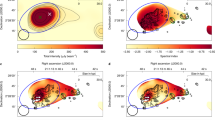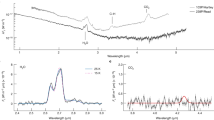Abstract
Observations of the varying orientations of comet tails led to the suggestion of the existence of the solar wind—a continuous outflow of ionized material from the Sun1. It is now well established that gas from comets is ionized by several processes and joins the solar wind2, forming an ion (plasma) tail that points away from the Sun. The plasma environments of three comets have been measured in situ, but only in the upstream direction or less than 8,000 km downstream of the nucleus. Here we report a fortuitous crossing by a spacecraft of the plasma tail of comet Hyakutake (C/1996 B2), at a distance of more than 3.8 astronomical units (550 million kilometres) from its nucleus. This surpasses the tail length of 2 au determined for the Great March Comet of 1843 (C/1843 D1)3. Our measurements reveal that, at this distance, the tail of comet Hyakutake was a structured entity at least 7 million kilometres in diameter.
This is a preview of subscription content, access via your institution
Access options
Subscribe to this journal
Receive 51 print issues and online access
$199.00 per year
only $3.90 per issue
Buy this article
- Purchase on Springer Link
- Instant access to full article PDF
Prices may be subject to local taxes which are calculated during checkout


Similar content being viewed by others
References
Biermann,L. Kometenschweife und solare Korpuskularstrahlung. Z. Astrophys. 29, 274–286 ( 1951).
Coates,A. J. Ionospheres and magnetospheres of comets. Adv. Space Res. 20, 255–266 (1997).
Ip,W. -H. & Axford,W. I. in Comets (ed. Wilkening, L. L.) 588–634 (University of Arizona Press, Tucson, 1982).
Riley,P., Gosling,J. T., McComas,D. J. & Forsyth,R. J. Ulysses observations of a “density hole” in the high-speed solar wind. J. Geophys. Res. A 103, 1933– 1940 (1998).
Balogh,A. et al. The magnetic field investigation on the Ulysses mission: Instrumentation and preliminary scientific results. Astron. Astrophys. Suppl. Ser. 92, 221–236 ( 1992).
Brandt,J. C. et al. Disconnection events (DEs) in Halley's comet 1985–1986: The correlation with crossings of the heliospheric current sheet (HCS). Icarus 137, 69–83 ( 1999).
Johnstone,A. D. et al. Ion flow at comet Halley. Nature 321 , 344–347 (1993).
Alfvén,H. On the theory of comet tails. Tellus 9, 92–96 (1957).
Slavin,J. A. et al. Giacobini-Zinner magnetotail: ICE magnetic field observations. Geophys. Res. Lett. 13, 283– 286 (1986).
Jockers,K. in Cometary Plasma Processes (ed. Johnstone, A. D.) 139– 152 (Geophysical Monograph 61, American Geophysical Union, Washington DC, 1991).
Bertaux,J. L. et al. Lyman-alpha observations of comet Hyakutake with SWAN on SOHO. Planet. Space Sci. 46, 555– 568 (1998).
Jorda,L., Crovisier,J. & Green, D. W. E. in Asteroids, Comets, Meteors 1991 (eds Harris, A. W. & Bowell, E.) 285–288 (Lunar and Planetary Institute, Houston, 1992).
Green,D. W. E. (ed.) IAU Circ. No. 6388 (1996).
Huddleston,D. E., Coates,A. J. & Johnstone, A. D. Predictions of the solar wind interaction with Comet Grigg-Skjellerup. Geophys. Res. Lett. 8, 837–840 (1992).
Bame,A. et al. The Ulysses solar wind plasma experiment. Astron. Astrophys. Suppl. Ser. 92, 237–265 (1992).
Gloeckler,G. et al. Interception of comet Hyakutake's ion tail at a distance of 500 million kilometres. Nature 404, 576– 578 (2000).
Gloeckler,G. et al. The solar wind ion composition spectrometer. Astron. Astrophys. Suppl. Ser. 92, 267–289 (1992).
Raeder,J., Neubauer,F. M., Ness,N. F. & Burlaga,L. F. Macroscopic perturbations of the IMF by P/Halley as seen by the Giotto magnetometer. Astron. Astrophys. 187, 61– 64 (1987).
Jones,G. H. Weak and Strong Comets in the Solar Wind. Thesis, Univ. London (1997).
Rauer,H., Wegmann,R., Schmidt,H. U. & Jockers,K. 3-D MHD simulations of the effect of comoving discontinuities in the solar-wind on cometary plasma tails. Astron. Astrophys. 295, 529–550 (1995).
Krankowsky,D. et al. In situ gas and ion measurements at comet Halley. Nature 321, 326–329 ( 1986).
Russell,C. T., Luhmann,J. G., Barnes,A., Mihalov,J. D. & Elphic, R. C. An unusual interplanetary event: encounter with a comet? Nature 305, 612– 615 (1983).
Lisse,C. M. et al. The nucleus of comet Hyakutake (C/1996 B2). Icarus 140, 189–204 ( 1999).
Sonnerup,B. U. O. & Cahill,L. J. Magnetopause structure and attitude from Explorer 12 observations. J. Geophys. Res. A 72, 171–183 ( 1967).
Acknowledgements
Ulysses research at Imperial College and Queen Mary and Westfield College is supported by the UK Particle Physics and Astronomy Research Council. We thank H. Mikuž for providing images obtained at the Črni Vrh Observatory, Slovenia.
Author information
Authors and Affiliations
Corresponding author
Rights and permissions
About this article
Cite this article
Jones, G., Balogh, A. & Horbury, T. Identification of comet Hyakutake's extremely long ion tail from magnetic field signatures. Nature 404, 574–576 (2000). https://doi.org/10.1038/35007011
Received:
Accepted:
Issue Date:
DOI: https://doi.org/10.1038/35007011
This article is cited by
-
Solar-Wind High-Speed Stream (HSS) Alfvén Wave Fluctuations at High Heliospheric Latitudes: Ulysses Observations During Two Solar-Cycle Minima
Solar Physics (2022)
-
Current Sheets, Plasmoids and Flux Ropes in the Heliosphere
Space Science Reviews (2021)
-
The Science of Sungrazers, Sunskirters, and Other Near-Sun Comets
Space Science Reviews (2018)
-
Plasma Flow and Related Phenomena in Planetary Aeronomy
Space Science Reviews (2008)
-
Pickup Ions and Cosmic Rays from Dust in the Heliosphere
Space Science Reviews (2007)
Comments
By submitting a comment you agree to abide by our Terms and Community Guidelines. If you find something abusive or that does not comply with our terms or guidelines please flag it as inappropriate.



